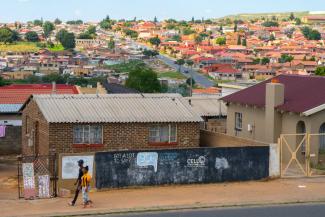Urban Development
Inclusive cities
 picture alliance/robertharding
picture alliance/robertharding
According to the authors, it is no longer convincing to argue that benefits will trickle down to poor communities when economies grow and additional wealth is created. Hence, the concept of inclusive development has become more popular. It is about promoting economic dynamism and gearing it to equality and social inclusion. The authors identify four main features:
- it goes beyond income, tackling cross-cutting issues such as gender or race,
- it considers who is included or excluded as well as who has the power to change things,
- it looks at the root causes and drivers of poverty and prosperity, and
- it considers social inclusion as part of economic processes rather than merely an outcome.
The study builds on the Rockefeller Inclusive Economies Framework, which offers relevant indicators. Those indicators help understand why an economy is not inclusive and how to steer it towards more equity, participation, growth, sustainability and stability.
In South Africa, inclusive development comes up frequently in national discourse. As Turok and Visagie write, the levels of income and wealth inequality are very high in South Africa, and intergenerational social mobility is low. The unemployment rate is between 26 % and 40 %, depending on how it is measured. Among young people between the ages of 15 and 24, it is as high as 55 %. Moreover, disparities are stark in regard to health, education, housing, access to water, sanitation et cetera.
Spacial disparities are often rooted in history, as Turok and Visagie show. More than 80 % of rural people live below the poverty line of R 1,300 (about € 77) per person and month – twice as many as in metropolitan areas. Two-thirds of rural households depend on social grants. In 2016, more people received social grants than held a job. The government has tried to alleviate suffering by redistributing resources, but it has not managed to set in motion economic progress or social mobility.
Many adults move to the cities in search of jobs. Turok and Visagie’s figures show that employment prospects are indeed better in the cities. Internal migrants, however, are vulnerable in specific ways. Many end up in informal settlements with inadequate shelter, poor transport and deficient basic services. To become more inclusive, cities would have to offer affordable housing, basic services and skills trainings.
The authors identify striking race-based patterns of exclusion in South African cities. The incomes of white households are three to four times higher than those of black households. Accordingly, black households are mostly confined to the urban periphery. Commuting thus costs them more time and money. Moreover, the best schools and health facilities tend to be closer to city centres, where security and recreational spaces are better too.
Home ownership in the cities is unattainable for many non-white households, so spatial segregation leads to social segregation. Cities lack attractive public spaces where people can interact across racial difference. This exacerbates the tendency of different groups leading separate lives, Turok and Visagie warn.
The authors conclude with three priorities for inclusive development in South Africa:
- Active citizenship should be supported by the state, for example when people take initiative to start businesses, migrate in search of jobs or become involved in political affairs.
- Urban agglomerations can boost economic inclusion, so they deserve state support for providing affordable housing and facilitating entrepreneurship.
- Government agencies and the private sector need to collaborate to achieve better results of development projects while also including local organisations and communities.
Link
Turok, I. and Visagie, J., 2018: Inclusive urban development in South Africa. What does it mean and how can it be measured?
http://opendocs.ids.ac.uk/opendocs/handle/123456789/13770